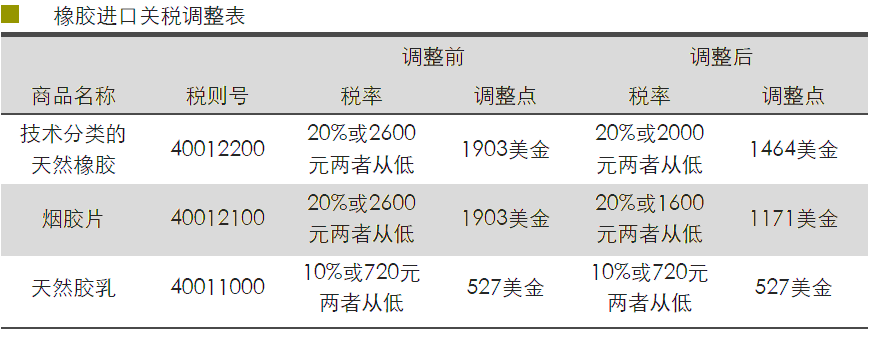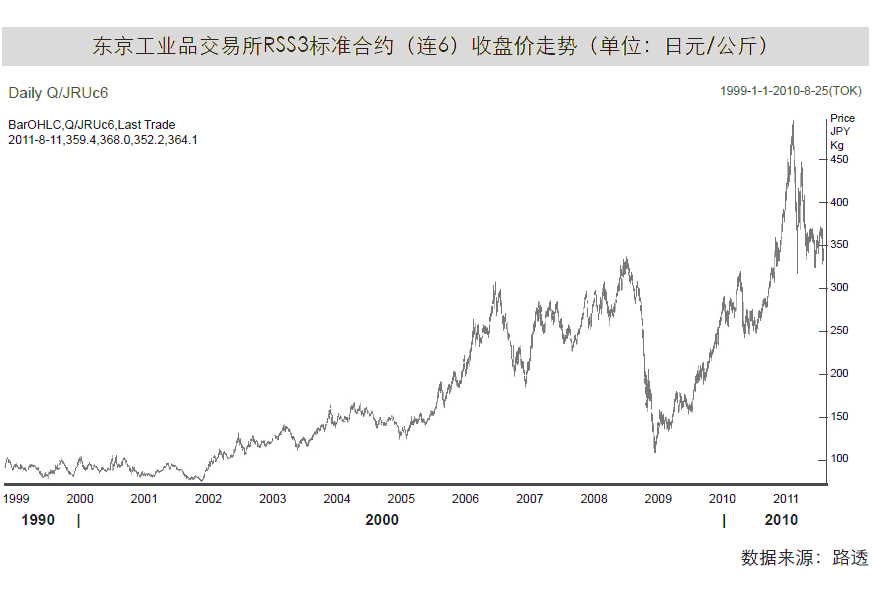natural rubber International supply and demand
Supply and demand is the most fundamental factor affecting the price of natural rubber. At present, the world's major natural rubber producers are Thailand, Indonesia, Malaysia, India, Vietnam and China. Since China and India use a large amount of rubber, Vietnam's production cannot compare with the above three countries at present, so the main natural rubber exporters are Thailand, Indonesia and Malaysia, The three countries have established the Natural Rubber Regional Sales Alliance (ITRCo) and the Natural Rubber Alliance (IRCo) in 2002. The purpose of this organization is to stabilize the price of rubber and maintain the long-term balance of rubber supply and demand. In March 2011, the earthquake in Japan led to a sharp decline in rubber prices. The International Rubber Alliance, represented by Thailand, declared that the domestic price should not be lower than 120 baht/kg. The countries and regions with the largest consumption of natural rubber in the world are China, India, the United States, Western Europe and Japan. China's own production of natural rubber, due to the rapid growth of consumption in the past two years, can only meet about one-fifth of its own consumption. The rest needs to be imported. India's self-sufficiency rate of natural rubber reaches 90%, while the United States, Western Europe and Japan are completely dependent on imports. Obviously, the supply and demand relationship for natural rubber between the three major natural rubber exporting countries and several major importing countries and regions has the most basic and crucial impact on the price of natural rubber. In addition, while paying attention to the production status of major natural rubber producing countries in the world, we should also pay attention to the development trend of natural rubber planting and production in Vietnam, India, Sri Lanka and other countries. Especially in Vietnam, the government announced that it will expand the planting area of natural rubber and adopt measures such as encouraging exports to increase the sales volume of natural rubber. The planting area has increased significantly in recent years, and it is expected that the global share will increase in the future. Since it takes more than 5 years for rubber trees to grow and produce rubber, attention should be paid to the delay period from expanding the planting area to the actual yield during analysis. The automobile industry has the largest consumption of natural rubber (accounting for about 65% of the total consumption of natural rubber). Therefore, the development of the automobile industry and related tire industries will affect the price of natural rubber. Inventory is also one of the important factors affecting the price of natural rubber.
Domestic supply and demand of natural rubber and tariff policy
China's domestic natural rubber has always been in a situation of supply exceeding demand. Therefore, before the natural rubber import was fully liberalized, the supply of domestic natural rubber still had a certain impact on China's natural rubber price.
However, after China's entry into WTO, how the government fulfills its WTO commitments and adjusts its import and export policies has become an important factor affecting China's natural rubber import and even the price fluctuation of natural rubber. China implements the "two licenses" management on the import of natural rubber. The specific contents are as follows: the imported natural rubber includes the processing part with supplied materials (zero tariff, no quota license restrictions since October 1, 1999), the double limited part (restrictions on flow and use, 5% tariff in 1997 and 1998, and 10% in 1999) and the general trade part (tariff before 2000 was 25%). The processing part with supplied materials and the double limit part are called the tax reduction part. The customs tracks the natural rubber imported in these two ways and supervises its flow direction and use. Only the general trade part can enter the circulation market and participate in the delivery of the futures market.
According to the tariff reduction obligations promised by China's accession to the World Trade Organization and the 2011 Tariff Implementation Plan issued by the Tariff Commission of the State Council, China will continue to implement the option tax on natural rubber in 2011.

International and domestic economic environment
As an important industrial raw material, the price fluctuation of natural rubber is closely related to the international and domestic economic environment. When the economic environment is good and the market demand is sufficient, the demand for natural rubber in the market will increase, thus driving up its price; On the contrary, when the economic environment is bad, the market is pessimistic and the demand is insufficient, the market's demand for natural rubber will decrease, which will promote its decline. The global economic crisis that broke out in 2008 led to a sharp decline in rubber prices, which is a clear proof. Therefore, the international and domestic economic environment will affect the long-term trend of natural rubber prices.
Development of main rubber industry
The largest consumption of natural rubber is the automobile industry (accounting for about 65% of the total consumption of natural rubber), and the development of the automobile industry drives the progress of the tire manufacturing industry. Therefore, the development of automobile industry and related tire industry will affect the price of natural rubber. Especially in the automotive industry, its development is directly related to the output of tires, thus affecting the global demand and price of natural rubber. After the automobile industry in Europe, America, Japan and other countries has entered a relatively stable development, the demand for natural rubber is relatively stable. By comparison, China's automobile industry has just started, and there is a lot of room for future development. Therefore, the domestic natural rubber price will be more affected by the development of the automobile industry and tire industry.
Production and application of synthetic rubber
With the continuous improvement of technology, the selection of raw materials for rubber products has also changed. Many products have used synthetic rubber instead of natural rubber. With the continuous development of synthetic rubber industry, its price is becoming more and more competitive. When the supply of natural rubber is tight or the price rises, many manufacturers will choose to use synthetic rubber, and the complementarity between the two will become stronger and stronger.
At the same time, as synthetic rubber is a petrochemical product, its price is naturally affected by its upstream product - oil. In fact, the oil price has always been fluctuating, so the fluctuation of oil price will also affect the price of natural rubber by affecting the price of synthetic rubber.
Natural factors
The growth of natural rubber trees has certain requirements for geographical and climatic conditions. The rubber trees suitable for tapping generally have a age of 5-7 years. Therefore, the number of natural rubber trees available for tapping cannot be changed in a short period of time. The main factors affecting the output of natural rubber are: 1. Seasonal factors. In the cutting season, the price of rubber fell; When cutting stopped, the price of rubber rose. 2. Climate factors. Typhoon or tropical storm, continuous rainy days, drought, frost, etc. will reduce the output of natural rubber and increase the price of rubber. 3. Pest and disease factors. Such as powdery mildew, red root disease, anthrax, etc., which will affect the growth of natural rubber trees, even lead to death, and have a great impact on the output and price of natural rubber.
Exchange rate change factors
In recent years, due to the turbulence of the global economy, the exchange rate changes frequently, which has a certain impact on the price of natural rubber, especially the import and export business. Therefore, when paying attention to the natural rubber market in the international market, we must pay attention to the exchange rate changes of countries, especially the three rubber producing countries, and the yen against the dollar. Data shows that, through correlation analysis, there is a certain correlation between the yen dollar exchange rate and the price of TOCOM natural rubber. Therefore, the change of the yen dollar exchange rate will have a corresponding impact on the cost of imported natural rubber, resulting in changes in domestic rubber prices.
Political factors
In addition to the policy influence of national governments on the import and export of natural rubber, political factors more importantly refer to international emergencies and major events that have occurred or will occur, such as catastrophic events and possible war factors. Political factors often lead to sharp fluctuations in the price of natural rubber in a short period of time when relevant news is spread, and affect its long-term price trend.
Impact of international market transactions
Natural rubber has become a mature variety in the international futures market, and has a certain market share in the futures exchanges of Southeast Asian countries. Therefore, the main places of natural rubber futures trading, such as TOCOM and OME in Japan, SHFE in China, SICOM in Singapore, KLCE in Malaysia, AFET in Thailand and other futures exchanges, also have different degrees of influence on each other.
For domestic natural rubber futures investors, when participating in SHFE natural rubber futures trading, they should not only pay attention to the trading situation of major foreign natural rubber futures markets, but also pay attention to the quotation situation of domestic spot markets such as Hainan, Yunnan and Qingdao.





